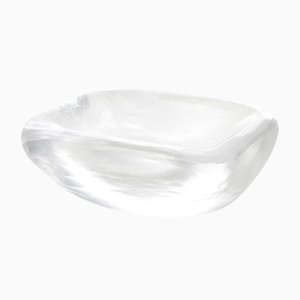
Born in 1904 in Gothenburg, Sweden, Victor Emanuel Lindstrand—aka Vicke Lindstrand—is revered as a pioneer of Swedish glass art. He is particularly celebrated for the technical dexterity of his enameled and engraved glass crafted via a vast array of techniques, many of which he revolutionized. Although Lindstrand’s pieces have become highly collectible in the years since his death, they were downplayed in his lifetime. To wit, his work was rejected by the Design in Scandinavia exhibition committee in midcentury.
Lindstrand studied commercial art and began a career in commercial illustration before moving into glasswork. In 1928, he was employed by Orrefors, where he began experiments in enameled glass—Graal-style vases, mostly—that were ultimately showcased in his design debut at the 1930 Stockholm World Fair. Cutting-edge and imaginative, the twelve vases exhibited there foreshadowed the exuberance of his later Orrefors output—like in his Pearl Driver Vase (1936), which depicted a single, suspended diver descending into currents and bubbles. While producing such designs, Lindstrand continued to experiment; it was at Orrefors that he, alongside Gustav Bergkvist and Edvin Öhrström, pioneered the Ariel technique, in which air bubbles are positioned in encased colored glass for decoration.
In 1942, Lindstrand left Orrefors to work for Uppsala-Ekeby, a ceramics manufacturer, where he designed groundbreaking pieces with simple lines and strong expressions, such as his Vase in Ceramic (ca. 1950s). After a 10-year tenure with the firm, he entered employment with Kosta glassworks—according to legend, Lindstrand’s Orrefors contract stated he was not allowed to work in the glass industry for 10 years after leaving. At Kosta, Lindstrand designed art glass similar to his Orrefors oeuvre, but he employed more color; among his most well-known pieces are his Höst Vase and his Atlantis Vases (both ca. 1950s), which depicted fishnet lines next to people or schools of fish.
Lindstrand left Kosta in 1972 and shifted to the Åhus-based Studio Glashyttan, where he stayed through the end of his career. He passed away in 1983.

